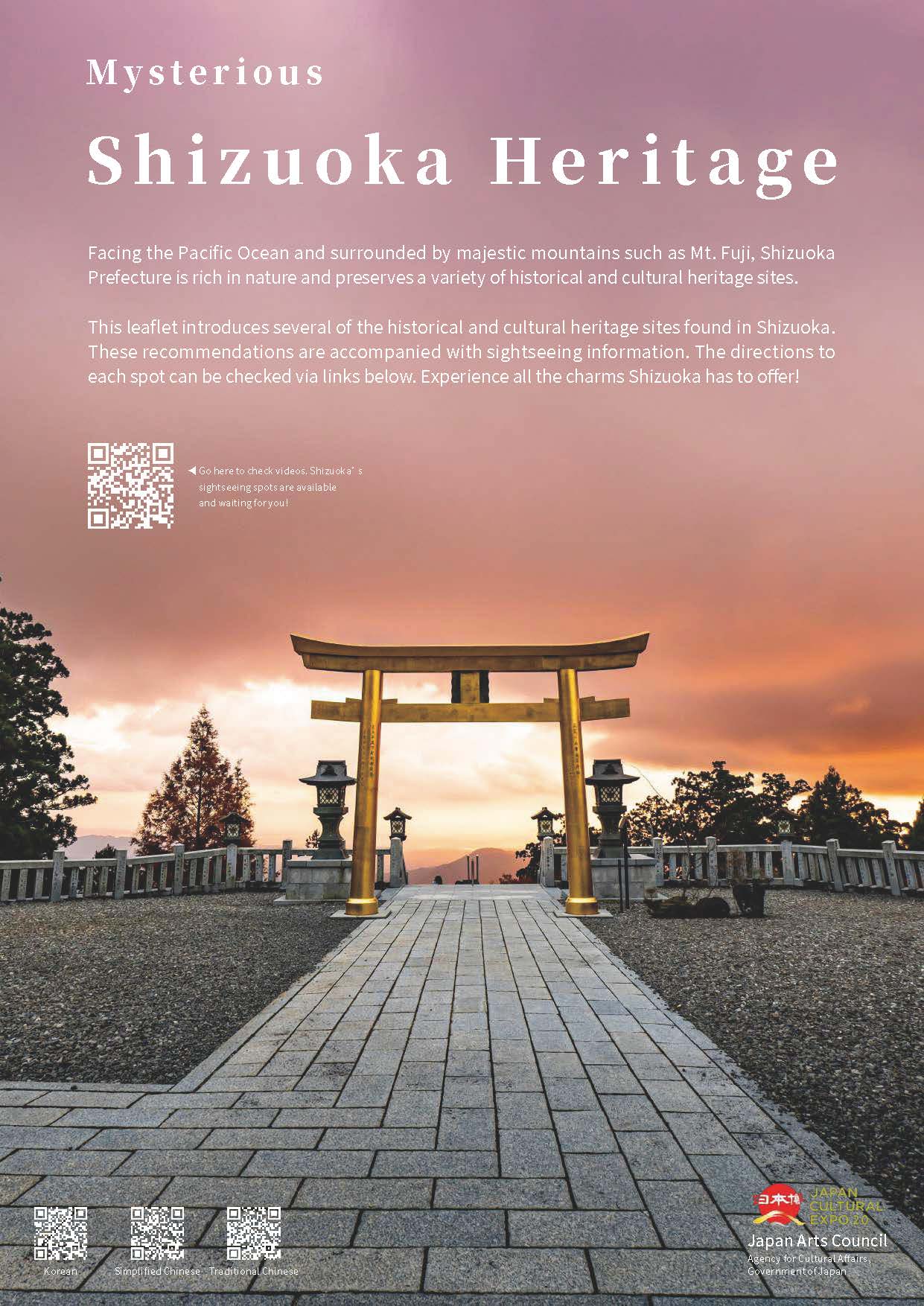
Cultural Properties in “Fuji-no-Kuni:” Shizuoka
Cultural Properties: priceless assets of the Japanese nation painstakingly developed and preserved over many centuries. The Japanese government identifies, selects and designates properties, giving them categorizations such as National Treasure, Important Cultural Property, Historic Site, Place of Scenic Beauty or Natural Monument, and overseeing their preservation and utilization. In Shizuoka Prefecture, over 800 Cultural Properties have been designated by the national and Prefectural governments, and they are joined by numerous other properties designated by local authorities or registered nationally. Lega-Shizu is a portal to deeper knowledge of these properties.
Mysterious
Shizuoka Heritage
Facing the Pacific Ocean and surrounded by majestic mountains such as Mt. Fuji, Shizuoka Prefecture is rich in nature and preserves a variety of historical and cultural heritage sites.
This leaflet introduces several of the historical and cultural heritage sites found in Shizuoka. These recommendations are accompanied with sightseeing information. The directions to each spot can be checked via links below. Experience all the charms Shizuoka has to ofer!
WATCH – Cultural Properties in Shizuoka
Shizuoka Prefecture produces videos and other materials to communicate the appeal of cultural assets. Through cultural assets, we can deepen our understanding of local history and culture, and pass on the region's precious treasures to the next generation.
The Rich Variety of Shizuoka

Shizuoka is resplendent with natural beauty, exemplified by Mount Fuji, the Izu Peninsula, Suruga Bay, the Tenryu River and Lake Hamana. It has long been a key link in the travel network across Japan, and has thus felt the influence of cultures the breadth of the archipelago, while also being the stage for numerous key moments in history. It is little surprise, then, that Shizuoka is blessed with many Tangible and Intangible Cultural Properties, which are showcased in this portal's Lega-Shizu Journey.
-
The visitor to Izu will find many Cultural Properties dating back to the birth of Japanese feudalism between the late Heian and early Kamakura periods, perhaps most notably the sculptor Unkei's seated Amida Nyorai, designated a National Treasure. Students of the Meiji Reformation will be fascinated by the Nirayama Reverbatory Furnaces (a World Heritage Site), and the Ryosenji and Gyokusenji temples (both Historic Sites), while Natural Monuments such as the Dogashima sea cave skylight and the columnar rocks in Tsumekizaki bear stirring witness to Izu's geological activity.
Lega-Shizu Journey
-
In the area around Mount Fuji - itself a World Heritage Site - visitors will find the Fujisan Hongu Sengen Taisha shrine (an Important Cultural Property and a Historic Site) and the Wakutamaike pond (a Special Natural Monument), reflections of Mount Fuji's societal and spiritual significance. The Kariyado-no-Gebazakura tree (a Special Natural Monument) and the Shiraito-no-taki waterfall (a Place of Scenic Beauty) are just two examples of many properties that afford a view of Mount Fuji itself.
Lega-Shizu Journey
-
Numerous temples and shrines here boast a connection to Tokugawa Ieyasu and the Edo Shogunate, such as Kunozan Toshogu (a National Treasure and Important Cultural Property) and Shizuoka Sengen Shrine (an Important Cultural Property), while the Oigawa-kawagoshi ruins, Utsunoya Pass (both Historic Sites), and historical documents in Seikenji temple related to the Chosen Tsushinshi evidence Shizuoka's history as a communications hub, and the mountainous regions still nurture long-running cultural arts such as the Kagura dance.
Lega-Shizu Journey
-
This area is blessed with countless properties referencing its people's faith: Yusanji's 3-storied pagoda, Soneiji temple's Niomon gate and Hokoji temple's Shichisonbosatsudo (all Important Cultural Properties), and Ryotanji temple garden (a Place of Scenic Beauty) to name but a few. The Tomida, Ogane and Kuroda residences (all Important Cultural Properties) are splendid examples of buildings used historically by local officials, and the Totomi Hiyondori and Okunai (Important Tangible Folk Cultual Properties) are fine specimens of the Ta-asobi and Dengaku dance traditions.
Lega-Shizu Journey

Our website is a portal site that disseminates various information about cultural assets in Shizuoka Prefecture.
The nickname 'Legacies' is derived from the English word 'Legacy,' meaning inheritance or something inherited, and 'Shizuoka'.
About the Logo
















